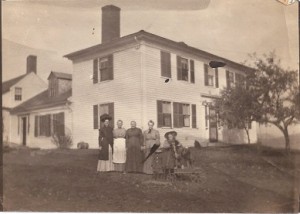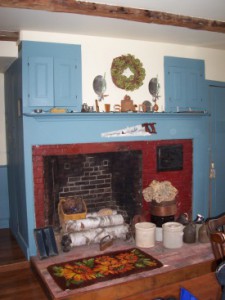
I have, on most occasions, an irreverent attitude toward my family history. I think the critical details of names, dates, and places are the foundation of any genealogical research, but beyond that it seems that those details can become ends in themselves. After years of traditional genealogical research, I try not to be caught up in the web of endless searching for this date, or that place; rather, I try to focus on the stories in the mêlée of my heritage. I’m seldom disappointed by the individual day-to-day lives; disappointment comes with the lack of information about them, even if it’s just an unnamed couple in a tintype.
I am always aware of my family’s continuity, and wonder at the changes in culture, ideas, and convictions over several generations. Over the generations and centuries of my family, I’ve found Catholics preceding Puritans who begat accused witches who came before Adventists who morphed into ordained Baptist ministers. We moved from aristocratic traitors to colonial patriots to adamant Women’s Christian Temperance Union members, and all without leaving Britain until the 1600s and staying in America ever since.

Continuity and tradition in my family root together. When Cousin Asa Williams, a fourth generation American colonist, built my house in Maine, he held true to his English culture and traditions by using a typically English style of ridge pole construction and brick spiral chimneys; I suspect he declined to supply his “king’s pines” for English ship masts, and he remained a staunch patriot until his death in 1820. (His friend, neighbor, and fellow patriot, my great-great-great-great-grandfather George Read, was so opposed to British oppression that he refused to whitewash his brick chimneys in the English tradition.) There is a wealth of continuity in my family history and properties, but tradition has been bought out. I bake my own bread, but it’s in a gas oven, not Eunice Williams’ brick one. My ancestors healed their families with herbal remedies (no eye of newt or toe of frog here, despite what you may have heard about my Salem ancestors), but I’m allergic to most of it.
Must I reconcile the saint with the Salem witch, the Catholic ancestor who lost his head (literally) on Tower Hill with the sermonizing Puritan minister who lost his head (figuratively) on the pulpit? Isn’t it enough to appreciate their lives, and marvel at the strength, accomplishment, and perseverance which brought the family thicket to its current form, thorns and all?
What a delightful summary! I too describe myself as interested in historical genealogy, not just names and dates. The richness of our checkered past, both saints and sinners, has made us who we are and their stories are so much more interesting than a homogeneous background. And to top it off, you have two cats and an old house like us. It just doesn’t get any better!
I find it a wonder that these people from different environments and evolving outlooks not only survive but also have children who survive so that you and I can be here.
Very fun article.
Hello Ms. Doerr, thank you for a level-headed perspective on genealogy. Is your George Read (perhaps The Signer) related to the George Read of DE and descendants? I have information about the George Read of DE, MS and AK who married Susan Chapman (widow of Wm Quarles Taliaferro, M.D. of VA and MS). Thank you.
Beverley Ballantine
Louisville KY
Hi Beverley – Thank you (all!) for your comments!
My family tends not so much to the illustrious as to the infamous. My George Read (1759-1849) is the farmer son of generations of farmer George Reads of Taunton, Massachusetts, the 3rd great grandson of immigrant William Read of St. Peters, Kent, England. While he answered the alarm of April 1775 in Rhode Island, as far as I know he didn’t leave Massachusetts until he moved to Maine in 1777. He could read and write, but he didn’t sign the Declaration of Independence!
This morning a first cousin once removed and I were discussing just this topic. By the way she is my cousin “no removed” about it. She has just finished a tribute photo album in honor of her mother. It contains some genealogical facts but more importantly it is filled with family photos, her mother’s favorite sayings, tidbits about their occupations and hobbies and trips with family and friends over the years. Many years from now when her great great grandchildren look through this album they will “know” their ancestors faces and what they believed and how they lived. What greater gift could she give to her descendants?
I inherited the family “list” of names and dates, and decided to verify them and then add stories to them. I had no idea what worlds I was opening up! First of all (of course), a lot of the names and dates didn’t stand up, in some cases entire lines fell apart, so I set it all aside to use as idea material. As I began at the beginning, I learned things about my parents’ and grandparents lives and I was hooked! Coming from a long line of storytellers, it’s the story that gets me every time. And each story gives me clues for the next generation back. To tell the truth, as far as genetics go, my sense of it is that you go back 6 or so generations and you’ve pretty well accounted for most of that. But beyond the genetics is the family dynamics and traditions,
the communities they were part of, the environments that shaped their decisions. I’ve found no hidden aristocracy, no famous personalities, just hard-working people living their lives and taking chances. My over-arching questions is this one: What were the motivations that made all these people from different places move from here to there, and then to another there? How did they all manage to somehow cross paths, create lives together, produce all those cousins? I love the digging, the discovery, the story suggested by the remnants of details I find. Now I feel I am passing along something to my children and my nieces and nephews, and maybe even some far-flung cousins. And it is so much fun!